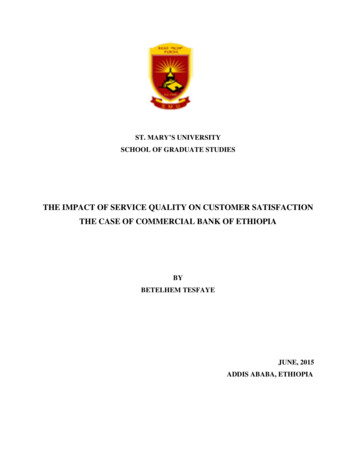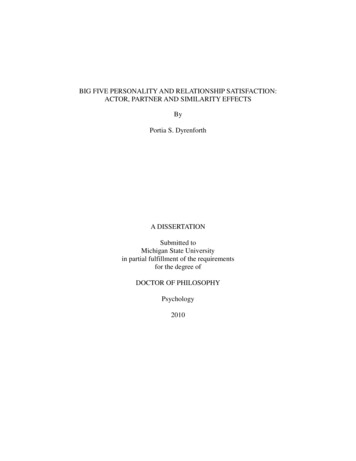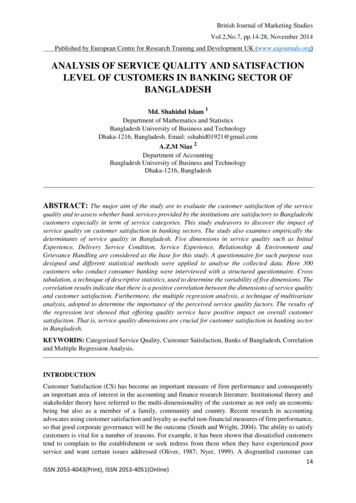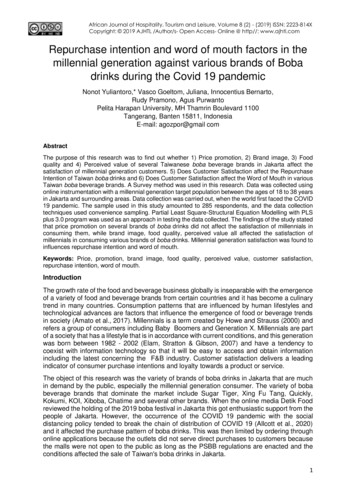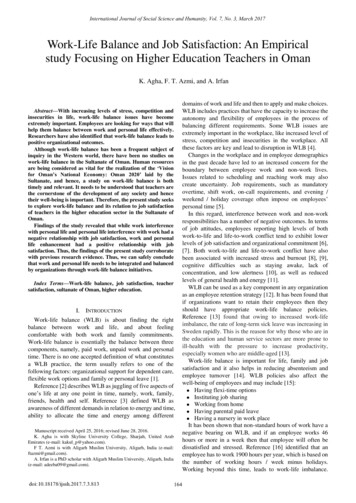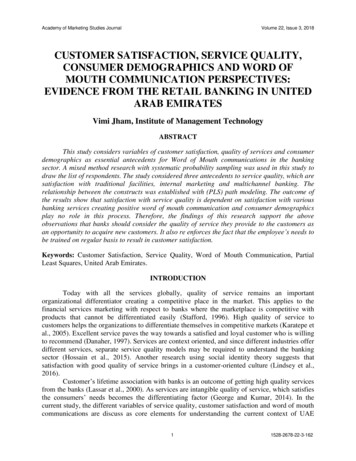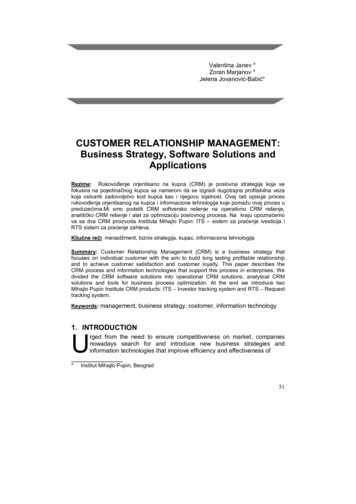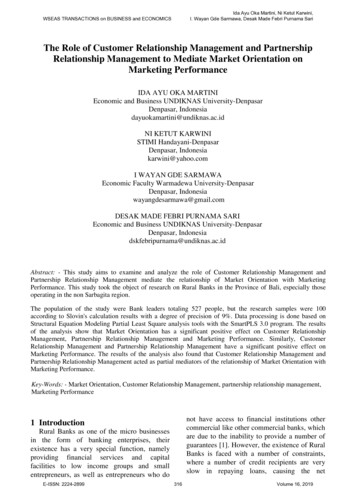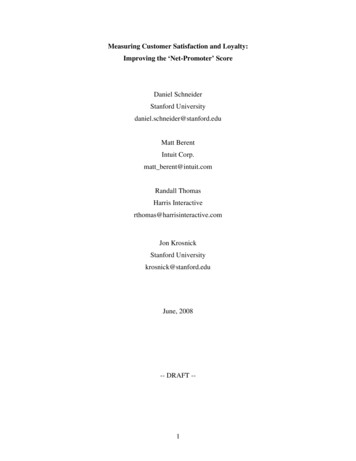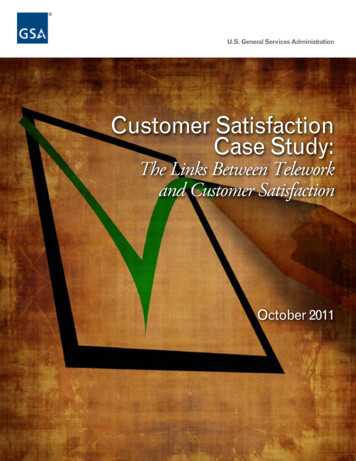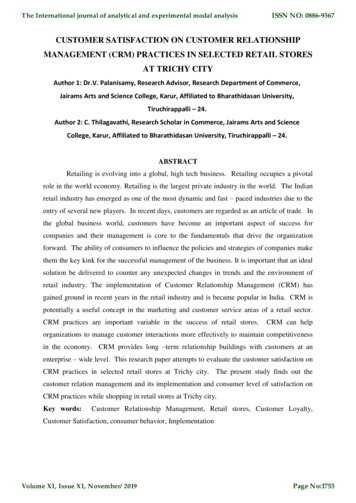
Transcription
The International journal of analytical and experimental modal analysisISSN NO: 0886-9367CUSTOMER SATISFACTION ON CUSTOMER RELATIONSHIPMANAGEMENT (CRM) PRACTICES IN SELECTED RETAIL STORESAT TRICHY CITYAuthor 1: Dr.V. Palanisamy, Research Advisor, Research Department of Commerce,Jairams Arts and Science College, Karur, Affiliated to Bharathidasan University,Tiruchirappalli – 24.Author 2: C. Thilagavathi, Research Scholar in Commerce, Jairams Arts and ScienceCollege, Karur, Affiliated to Bharathidasan University, Tiruchirappalli – 24.ABSTRACTRetailing is evolving into a global, high tech business. Retailing occupies a pivotalrole in the world economy. Retailing is the largest private industry in the world. The Indianretail industry has emerged as one of the most dynamic and fast – paced industries due to theentry of several new players. In recent days, customers are regarded as an article of trade. Inthe global business world, customers have become an important aspect of success forcompanies and their management is core to the fundamentals that drive the organizationforward. The ability of consumers to influence the policies and strategies of companies makethem the key kink for the successful management of the business. It is important that an idealsolution be delivered to counter any unexpected changes in trends and the environment ofretail industry. The implementation of Customer Relationship Management (CRM) hasgained ground in recent years in the retail industry and is became popular in India. CRM ispotentially a useful concept in the marketing and customer service areas of a retail sector.CRM practices are important variable in the success of retail stores.CRM can helporganizations to manage customer interactions more effectively to maintain competitivenessin the economy. CRM provides long –term relationship buildings with customers at anenterprise – wide level. This research paper attempts to evaluate the customer satisfaction onCRM practices in selected retail stores at Trichy city. The present study finds out thecustomer relation management and its implementation and consumer level of satisfaction onCRM practices while shopping in retail stores at Trichy city.Key words:Customer Relationship Management, Retail stores, Customer Loyalty,Customer Satisfaction, consumer behavior, ImplementationVolume XI, Issue XI, November/2019Page No:1753
The International journal of analytical and experimental modal analysisISSN NO: 0886-9367INTRODUCTIONRetail Sector is one of the fastest growing sectors in India over the last few years. Inrecent days, customers are regarded as an article of trade. Customers are the primary sourcethat businesses exist; marketing has become the core component for successful managementof the organization. For most businesses, marketing can account for almost of the productsale price, provided services such as distribution and promotion are accounted for this. Forany business to succeed with its customers, they need to understand the customers. Hence,implementation of CRM is essential to understand the customers. The term CRM is used todefine the tools and technologies used b y an enterprise to manage the relationships with itscustomers. CRM is a process of learning by which organizations can develop strongerrelationships with customers having gained information on their needs and behaviours.Retail Industry Scenario in IndiaRetailing is the most active and attractive sector of last decade. While the retailingindustry itself has been present since ages in our country, it is only the recent past that it haswitnessed so much dynamism. The emergence of retailing in India has more to do with theincreased purchasing power of buyers, especially post – liberalization, increase in productvariety, and increase in economies of scale, with the aid of modern supply and distributionssolution.The overall retail market in India 2018 stood at Rs 43,251 billion and is forecastto grow by 6.4 percent CAGR in 2018-2023.Indian retailing today is at an interesting crossroads. The retail sales are at the highestpoint in history and new technologies are improving retail productivity. The Indian retailindustry has emerged as one of the most dynamic and fast – paced industries due to the entryof several new players. The retail sector in India is dominated by the unorganized retailtrade, where unorganised trade forms around 93% of the overall trade. This is in contrastwith the developed countries where the organised retail industry accounts for almost anaverage of more than 80% of the total retail trade. This highlights a lot of scope for furtherpenetration of organized retail in India.The overall retail market in India is expected togrow at 12% growth rate per annum, driven by growing urbanization, rising income,demographics and rising aspirations of the middle class. Modern trade is going to expand astwice as fast at 20% per annum and traditional trade is expected to grow at 10%.Volume XI, Issue XI, November/2019Page No:1754
The International journal of analytical and experimental modal analysisISSN NO: 0886-9367Customer Relationship ManagementCustomer Relationship Management (CRM) is the combination of practices, strategiesand technologies that companies use to manage and analyze customer interactions and datathroughout the customer lifecycle, with the goal of improving customer service relationshipsand assisting in customer retention and driving sales growth.CRM systems compilecustomer data across different channels. CRM system can also give customer facing staffdetailed information on customers’ personal information, purchase history, buyingpreferences and concerns.Benefits of CRMThe primary benefits of CRM include significant improvement to the marketingtechniques, as well as better chances of customer satisfaction and retention and growth inmarket share for the business. By ensuring that the system targets customers with high valuepropositions that satisfy their needs.CRM improves marketing tools used by andorganisation. Upon improving its product offerings, a business gains the ability to retain itscustomers and establish a sense of loyalty between each other. It is important for betterservices to be maintained over time, which generated enough positive marketing from wordof mouth to help establish a significant level of growth in the market.Key principle of Customer Relationship aborationListening &LearningpostsTouch pointalignmentReal timeinformationManagerone and doneCustomer satisfactionCustomer satisfaction is defined as a measurement that determines howhappy customers are with a company's products, services, and capabilities. Customersatisfaction information, including surveys and ratings, can help a company determine howVolume XI, Issue XI, November/2019Page No:1755
The International journal of analytical and experimental modal analysisISSN NO: 0886-9367to best improve or changes its products and services. Satisfaction means the contentment onefeels when one has fulfilled a desire, need or expectation. Furthermore, Customer satisfactioncan be a measure of how happy customers are with the services and products of a retailstores. Keeping customers happy is of tremendous benefit to companies. Satisfied customersare more likely to stay loyal, consume more and are more likely to recommend their friendsto the business.Customer satisfaction occurs when the value and customer service provided through aretailing experience meet or exceed consumer expectations. If the expectations of value andcustomer service are not met, the consumer will be dissatisfied. Only very satisfied customersare likely to remain loyal in the long run. (Levy, Michael, Weiz, Barton A,Retailingmanagement 2004,2) Customer satisfaction in a retailing should be a long-term aim andconcentrate into an existing customer rather than replace dissatisfied customers with newones. It is extremely important to satisfy customers because a retailer’s sale comes from twogroups of customers: new customers and repeat customers. In retailing, attracting newcustomers is likely to cost company five times as much as pleasing an existing customer.Customer retention is more important than customer attraction, and a key to customerretention is customer satisfaction.Review of LiteratureAccording to Chen and Popovich(2003), CRM is not a concept that is really new butrather due to current development and advances in information and enterprise softwaretechnology, it has assumed practical importance.The root of CRM is relationship marketing,which has the objective of improving the long-term profitability of customers by movingaway from product-centric marketing.Bose (2002) noted that CRM was invented because the customers differ in theirpreferences and purchasing habits. If all customers were alike, there will be little need forCRM. As a result, understanding customer drivers and customer profitability, firms can bettertailor their offerings to maximize the overall value of their customer portfolio.According to Greenberg (2004), CRM generally is an enterprise-focused endeavorencompassing all departments in a business . He further explains that, in addition to customerservice, CRM would also include, manufacturing, product testing, assembling as well aspurchasing, and billing, and human resource, marketing, sales and engineering.Volume XI, Issue XI, November/2019Page No:1756
The International journal of analytical and experimental modal analysisISSN NO: 0886-9367Darshan Desai, Sabrat Sahu and Piyush Kumar Sinha (2007) on the basisof analytical and empirical or case research conducted a random sample study of 334executives was selected from 29 firms in the following industries: retail (n 60), telecom(n 80) and banking (n 183) in India.They also concluded that.Impact of marketorientation on dynamic capability of CRM and competitive CRM performance may be theresult and shaping the organizational resources that no longer match the environment. Theseinclude processes like analysis customers, developing and delivering tailored offering,providing customer service, orchestrating linkages, assigning accountability and evaluatingperformance.Yuen & Chan (2010) assert that in today‟s competitive grocery store sector,customer demands are bound to increase from time to time due to the improvement of servicequality in parallel with product variety. Due to the tremendous growth of service industry inwhich retailing sector plays an important role, it is vital for retailers to understand the degreeof importance of listening to the inner voice of customers needs to create, increase level ofsatisfaction.Objectives of the study To analyse CRM practices followed by retail stores in Trichy city. To evaluate the relationship between CRM and customer satisfaction. To study the benefits of CRM to the customers. To understand the impact of CRM in retail stores To find out the factors determining purchase decisionMethodologyThe study was conducted through questionnaire method.Sample SizeThe sample size taken up for this study is 100 respondents from retail shops in Trichycity.Primary Data and Secondary DataPrimary data is collected through questionnaire. Secondary data has been collectedfrom Journals, Websites, Magazines and News Papers.Table No. 1Types of retail stores like to purchaseOPTIONSHypermarketsVolume XI, Issue XI, November/2019FREQUENCY PERCENTAGE1818Page No:1757
The International journal of analytical and experimental modal analysisDepartmental stores3636Convenience stores1414Super markets3232Total100100ISSN NO: 0886-9367Source: Primary DataFrom the above table depicts that, the majority (36%) of the respondents purchasedgoods from departmental stores, 32% of them are purchased goods from super markets, 18%of them prefer hypermarkets and 14% of them preferred convenience stores to purchaseproducts.Table No. 2Types of products like to purchase in retail storesOPTIONSFREQUENCY PERCENTAGEElectronics goods2222Cloth3030Food items &Grocery3838Others2020Total100100Source: Primary DataFrom the above table, it is inferred that the majority (38%) of the respondentspurchase food items and grocery, 22% of them purchased electronic goods, 30% of them arepurchased cloth and 20% of them purchased other products from retail stores.Table No. 3Opinion about the services offered by retail stores to its customersOPTIONSFREQUENCY 6Total100100Source: Primary DataThe analysis of the above table shows that, the majority 58% of the respondents areopined that they are satisfied with the services offered by retail stores, 22% are feel theservices are good, 14% are opined that the services are average and only 6% of therespondents opined that the services offered by retail stores is poor.Volume XI, Issue XI, November/2019Page No:1758
The International journal of analytical and experimental modal analysisISSN NO: 0886-9367Chart No. 1Opinion about the services offered by retail stores to its Table No. 4Retail stores collecting customer databaseOPTIONS FREQUENCY PERCENTAGEYes9292No88Total100100Source: Primary DataFrom the above table, it is clearly indicates that Majority (92%) of the retailerscollecting the customer data base. Only 8% of the retailer’s does not collecting customer database. Customer database helps the retailer to identify the loyal customers.Table No. 5Techniques / Methods used to collect customer informationOPTIONSEntry formsVolume XI, Issue XI, November/2019FREQUENCY PERCENTAGE4040Page No:1759
The International journal of analytical and experimental modal analysisFeedback forms3232Bill records1818Others1010100100TotalISSN NO: 0886-9367Source: Primary DataFrom the above table, it is inferred that the majority of the Retailers used entry formsto collect the information about the customers. 32% of the retail stores collect customer’sdetails through feedback forms. 18% of retail stores collect customer data and informationthrough bill records and 10% belongs to other forms.Table No. 6Different types of information collected by retailers from respondentsOPTIONSFREQUENCY PERCENTAGEPersonal information2424Family information1212Feed back2222Income1212Address1010All type of information2020Total100100Source: Primary DataFrom the above table shows that, Majority 24% of the retailers collected personalinformation from the customers, 12% are collected family information, 22% are collectedfeedback, 12% are collected income details, 10% are collected address and 20% of theretailers collected all type of above information from the customers of retail stores.Table No. 7Factors determining purchase decisionOPTIONSFREQUENCY PERCENTAGEQuality products4242Door delivery1616Membership card88Sitting facility66Billing facility1010Child play area66Volume XI, Issue XI, November/2019Page No:1760
The International journal of analytical and experimental modal analysisPromotional schemes1212Total100100ISSN NO: 0886-9367Source: Primary DataFrom the above table, it clearly shows that the majority (42%) of the respondentsdetermine to purchase for the reason of quality products. 16% door delivery, 8% membershipcard, 6% sitting facility, 10% quick billing facility, 6% child play area and 12% of therespondents are influenced to determine to take purchase decision for promotional schemes.Chart No. 2Factors determining purchase factory141466AveragePoorTotal*Table No. 8Loyalty card provided by retailersOPTIONS FREQUENCY PERCENTAGEYes8686No1414Total100100Source: Primary DataFrom the above table, it is inferred that majority (86%) of the retailers provideloyalty card to its customers. Only 14% of them are not provided loyalty cards.Volume XI, Issue XI, November/2019Page No:1761
The International journal of analytical and experimental modal analysisISSN NO: 0886-9367Table No. 9Methods followed by a retailer to maintain customer loyaltyOPTIONSFREQUENCY PERCENTAGEAccepting credit / debit cards4646Loyalty cards2222Accepting mail orders1212Credit sales1414Others66Total100100Source: Primary DataFrom the above table, it is clearly shows that the various methods followed by aretailer to maintain customer loyalty. Majority (46%) of the retailers focused on acceptingcredit cards and debit cards to make purchase. 22% of the retailers used to provide loyaltycards to its customers to maintain customer loyalty. 12% of the retailers accepting mailorders, 14% of them are providing credit sales facilities to its customers and 6% of them aregiven guarantee and response forms to maintain customer loyalty.Table No. 10Opinion about the promotional schemes delight the customerOPTIONSFREQUENCY PERCENTAGEStrongly agree4444Agree2020Neutral1111Disagree1313Strongly disagree1212Total100100Source: Primary DataFrom the above table, it clearly indicates 44% of the respondents opined that they feeldelighted about the promotion schemes offered by retail stores. 20% are agreed, 11% opinedthat they feel neutral about the promotional schemes. 13% of them disagreed and 12% ofthem strongly disagree the statement.Volume XI, Issue XI, November/2019Page No:1762
The International journal of analytical and experimental modal analysisISSN NO: 0886-9367Table No. 11Various schemes offered by retailers to maintain good relationship with customerOPTIONSFREQUENCY PERCENTAGEDiscount offers3636Gift coupons1818Membership card1010Free door delivery1616Regular feedback1212Others88Total100100Source: Primary DataFrom the above table, it inferred that the various schemes offered by a retailer toattract consumers and maintain a good relationship with the customers. Majority (36%) ofthe retailers offered discount offers in festival seasons to attract the customers. 18% of theretailers offered gift coupons, 10% are offered membership card, 16% are provided free doordelivery service, 12% are getting regular feedback from customers and remaining 8% of theretailers are offered some other schemes to maintain good relationship with their customers.Chart No.3Various schemes offered by retailers to maintain good relationship with %3%Table No. 12Greetings send by retailersOPTIONS FREQUENCY PERCENTAGEYes9090No1010Volume XI, Issue XI, November/2019Page No:1763
The International journal of analytical and experimental modal analysisTotal100ISSN NO: 0886-9367100Source: Primary DataFrom the above table, it clearly indicates the opinion about the retailers sendingbirthday / anniversary / festival greetings to their customers. Majority (90%) of the retailersare sending greeting to their customers for their birthday / anniversary / festival. Only 10%of the respondents are not sending any greeting to their customers.Table No. 13Feedback collected by retailersOPTIONS FREQUENCY PERCENTAGEYes8080No2020Total100100Source: Primary DataFrom the above table, it is interprets that, Majority (80%) of the respondents opinedthat the retailers are collecting feedback about their service from customers. Only 20% ofthem are says that the retailers are not collected any feedback from customers.Table No. 14Methods to collect feedback about level of satisfaction from customersOPTIONSFREQUENCY PERCENTAGEFeedback forms4040Suggestion box2424Sending SMS1212Follow up telephone calls1616Others88Total100100Source: Primary DataIt is inferred that, the various methods followed by the retailers to collect feedbackfrom customers.40% of the retailers used feedback forms to collect feedback fromcustomers. 24% of them followed suggestion box method, 12% of them sending SMS totheir customers and enquired about their level of satisfaction, 16% of the retailers tracking thecustomer satisfaction through follow up telephone calls and 8% of the retailers used othermethods to tracking the customer satisfaction.Volume XI, Issue XI, November/2019Page No:1764
The International journal of analytical and experimental modal analysisISSN NO: 0886-9367Table No. 15Overall satisfaction regarding the retail storesOPTIONSFREQUENCY rage77Poor44Total100100Source: Primary DataFrom the above table clearly shows the overall level of satisfaction regarding theretail stores. Majority 41% of the respondents are satisfied with retail outlets. 18% of themopined that they feel excellent, 30% of the respondents are opined that they feel good, 7%feels average and only 4% of them opined that their satisfaction level is poor.Chart No. 4Overall satisfaction regarding the retail stores7 s Majority (36%) of the respondents purchased goods from departmental stores. Majority (38%) of the respondents purchase food items and grocery.Volume XI, Issue XI, November/2019Page No:1765
The International journal of analytical and experimental modal analysisISSN NO: 0886-9367 Majority 58% of the respondents are opined that they are satisfied with the servicesoffered by retail stores. Majority (92%) of the retailers collecting the customer data base. Majority 24% of the retailers collected personal information from the customers. Majority (42%) of the respondents determine to purchase for the reason of qualityproducts. Majority (36%) of the retailers offered discount offers in festival seasons to attract thecustomers. Majority 41% of the respondents are satisfied with retail outlets.ConclusionCRM practices play an essential role in the success of the business. This study helpsto identify the customer satisfaction on CRM practices followed by retailers in retail stores atTrichy city. This study has identified the various factors determining the purchase decision ofthe customer. CRM techniques and methods used by a retailer will helps to maintaincustomer loyalty. Timely feedback from the customers should be taken by the retail store itwould make the customers realize that they are important for the growth of the organisation.CRM is highly exercised in all the industries but it is having importance in retail industry forits growth. Every firm is striving to establish and maintain customer relationship in order tosustain its business and profitability.References Bose, R. (2002). Customer Relationship Management; Key Components for ITSuccess Industrial Management and Data Systems, 102(2), 89-97. Darvish, H., Kafashzadeh, A. R., & Ahmadnia, H. (2012). Studying the customerrelationship management: A case study at Persian technology firm. Economic Insights– Trends and Challenges, 64, 1-18. Levy, Michael, Weiz, Barton A 2004 Retailing management.5th international edition.Boston,McGraw-Hill. Gee, R., Coates, G. & Nicholson, M. (2008). Understanding and profitably managingcustomer trust. Marketing Intelligence & Planning, 26(4), 359 - 374. DOI:10.1108/02634500810879278 Benjamin Appiah - Kubi & Andrews, K. D (2010): “Towards a successful customerrelationship management: A conceptual framework” African Journal of MarketingManagement ,Vol. 2(3) pp.037-043.Volume XI, Issue XI, November/2019Page No:1766
The International journal of analytical and experimental modal analysis ISSN NO: 0886-9367Warrington P, Gansted E, Feinberg R & de Ruyter K (2007), Multi – channel retailingand customer satisfaction: implications for e- CRM. International Journal of EBusiness Research 3(2),p 57 – 69.Volume XI, Issue XI, November/2019Page No:1767
The implementation of Customer Relationship Management (CRM) has gained ground in recent years in the retail industry and is became popular in India. CRM is potentially a useful concept in the marketing and customer service areas of a retail sector. CRM practices are important variable in the success of retail stores. CRM can help

